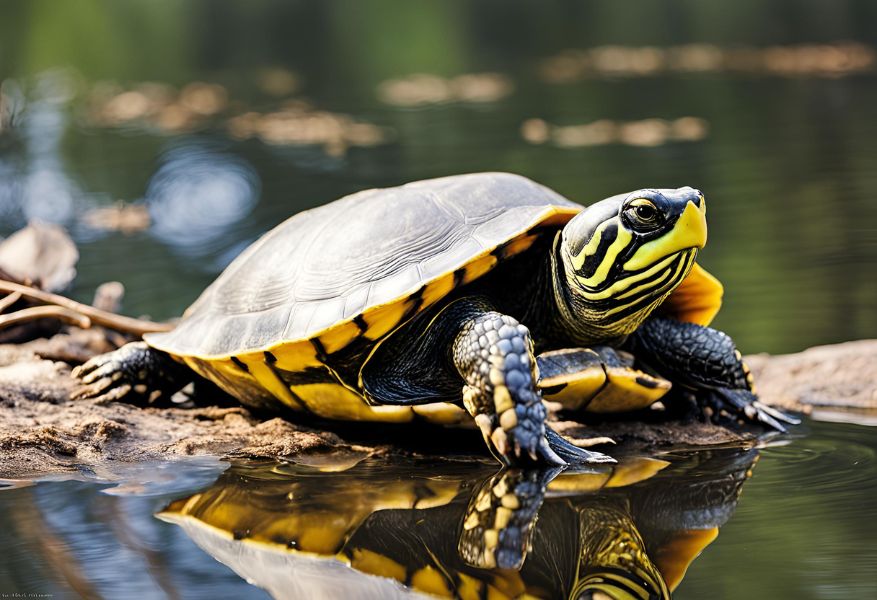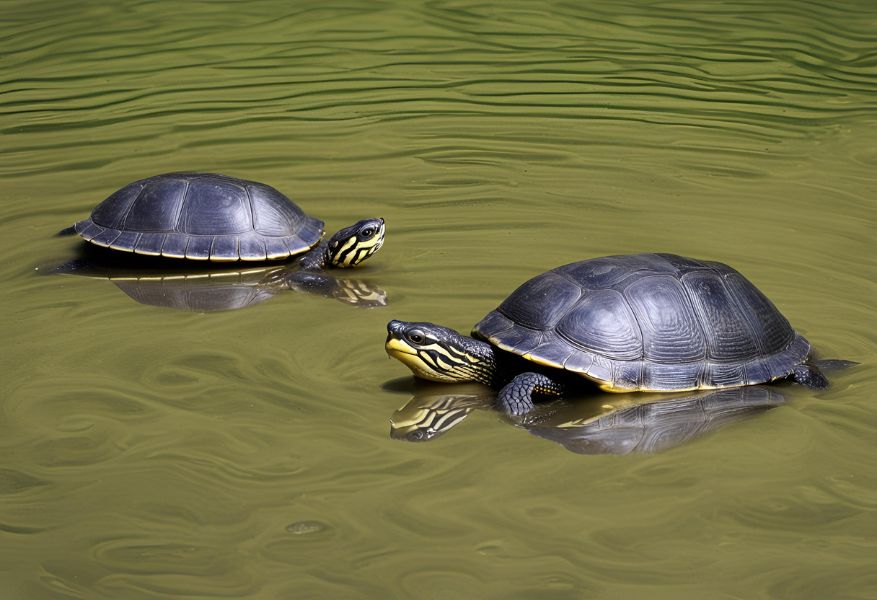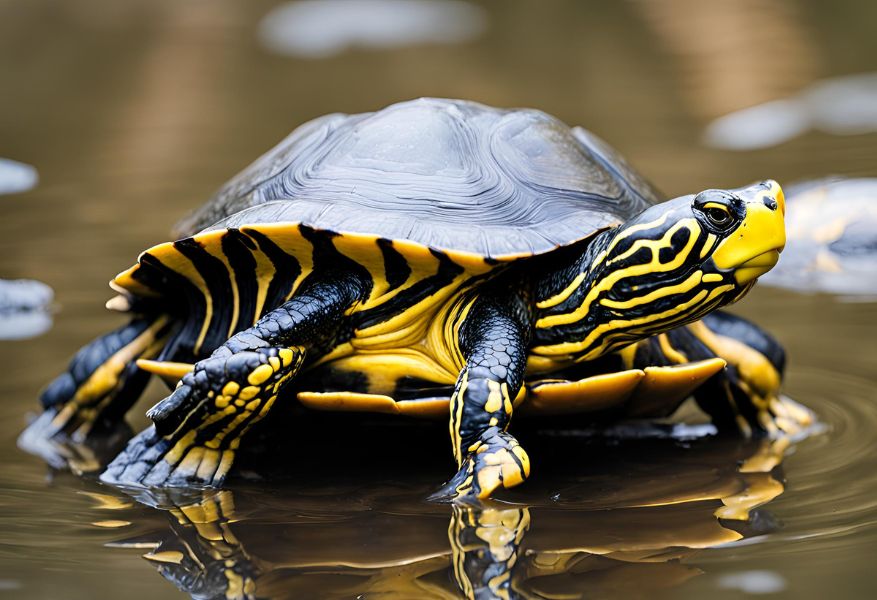Yellow-bellied sliders (Trachemys scripta scripta) are semi-aquatic turtles that can stay out of water for extended periods, ranging from several hours to several weeks, depending on various factors.
Surviving Out of Water: The Remarkable Adaptations of Yellow-Bellied Turtles
When it comes to surviving out of their aquatic habitats, yellow-bellied turtles are true champions. These fascinating reptiles possess unique adaptations that allow them to thrive in both water and land environments, making them a captivating subject for turtle enthusiasts and nature lovers alike.
The Aquatic Haven
Before delving into their remarkable ability to stay out of water, it’s essential to understand the natural habitat of yellow-bellied turtles. These turtles are native to the southeastern United States and are commonly found in slow-moving rivers, ponds, and marshes. Their aquatic environments provide them with ample opportunities for basking, feeding, and socializing.

Factors Influencing Time Out of Water
The duration a yellow-bellied turtle can stay out of water is influenced by several key factors. Understanding these factors will help you appreciate the incredible resilience and adaptability of these reptiles.
Temperature and Humidity
One of the most crucial factors determining how long a yellow-bellied turtle can remain out of water is the ambient temperature and humidity levels. These turtles are ectothermic, meaning they rely on external sources to regulate their body temperature. In warm and humid conditions, they can stay out of water for extended periods without dehydrating or overheating.
Age and Size
Younger and smaller yellow-bellied turtles have a higher surface area-to-volume ratio, which means they lose moisture more rapidly than their larger counterparts. As a result, younger turtles may need to return to the water more frequently to rehydrate and cool down.
Basking Behavior
Basking is an essential activity for yellow-bellied turtles, as it helps them regulate their body temperature and synthesize vitamin D. During basking sessions, these turtles can remain out of water for several hours, often rotating between the water and basking areas to maintain optimal body temperature.
Seasonal Variations
The ability of yellow-bellied turtles to stay out of water can also vary depending on the season. During the warmer months, when temperatures are higher and water sources are abundant, they may spend more time basking and exploring on land. However, in the cooler months or during drought conditions, they may spend more time in the water to conserve energy and avoid dehydration.

Remarkable Time
Frames Now, let’s explore the remarkable time frames that yellow-bellied turtles can stay out of water. While the exact duration can vary based on the factors mentioned above, these turtles have demonstrated remarkable endurance:
- Short-term Excursions: Yellow-bellied turtles can typically stay out of water for several hours, up to a day or two, without any significant issues. This allows them to bask, forage for food, and explore their surroundings.
- Extended Periods: In optimal conditions, with adequate shelter, humidity, and access to water sources, yellow-bellied turtles have been known to remain out of water for several weeks or even months. This is particularly common during the breeding season when males may travel long distances in search of mates.
- Hibernation and Brumation: During the winter months, yellow-bellied turtles may undergo brumation, a state of dormancy similar to hibernation. In this state, their metabolic rates decrease significantly, allowing them to conserve energy and stay out of water for extended periods, sometimes up to several months.
Providing Optimal Conditions
For those keeping yellow-bellied turtles as pets or in captive settings, it’s essential to provide them with the appropriate conditions to ensure their well-being. This includes:
- Basking Area: Offering a suitable basking area with adequate warmth and humidity levels is crucial for their thermoregulation and overall health.
- Shelter: Providing hiding spots or shelters can help the turtles feel secure and reduce stress when they’re out of water.
- Water Access: Ensuring access to a clean water source allows the turtles to rehydrate and cool off as needed.
- Proper Diet: Maintaining a balanced and nutritious diet helps support the turtles’ overall health and resilience.
By understanding and replicating these conditions, responsible pet owners and caretakers can ensure their yellow-bellied turtles thrive and enjoy the benefits of spending time both in and out of water.
Yellow Eared Slider
If you’re looking for a pet turtle that’s both beautiful and unique, the yellow-eared slider (Trachemys scripta elegans) is an excellent choice. This species gets its name from the distinctive yellow markings on its head and ears, which are set against a dark green or black shell. Yellow-eared sliders are semi-aquatic, meaning they spend part of their time in water and part of their time on land.
In the wild, they can be found in ponds, lakes, and slow-moving rivers throughout the southeastern United States.
While they make great pets, yellow-eared sliders require a bit more care than some other turtles. They need a large tank or pond (at least 10 gallons for each inch of shell length), with both land and water areas.
The water should be kept clean and warm (around 75 degrees Fahrenheit), with a filter to remove waste products. A basking spot with a heat lamp is also necessary to provide your turtle with the warmth it needs to digest its food properly.
Yellow-eared sliders are omnivorous, eating both plants and animals.
In captivity, they can be fed commercial turtle pellets, as well as fresh vegetables like lettuce, kale, and squash. Live foods such as crickets or earthworms should also be offered several times per week. With proper care, yellow-eared sliders can live for 20 years or more!

Can Yellow-Bellied Sliders Be Out of Water?
Yes, yellow-bellied sliders can be out of water for short periods of time. They are semi-aquatic turtles and so they are able to live in both water and on land. However, they cannot stay out of water for too long or they will dehydrate and die.
If you see a yellow-bellied slider turtle out of the water, it is best to put it back in as soon as possible.

How Long Can Turtles Stay Out of Water?
Turtles are reptiles that need both land and water to survive. They spend most of their time in the water, but they do need to come up for air. How long a turtle can stay out of water differs from species to species, but all turtles will eventually drown if they are not able to get back into the water.
Some turtles, such as the common box turtle, can live their entire lives without ever getting into a body of water larger than a puddle. These types of turtles get all the moisture they need from the food they eat and from dew that collects on leaves and grasses overnight. Other turtles, such as sea turtles, can only survive for a few hours out of the water before they start to dehydrate and die.
If you find a turtle that is stranded on land far away from any bodies of water, it is best to call a wildlife rehabilitation center or veterinarian who can help you safely transport the turtle back to its natural habitat.
Can Yellow Belly Turtles Live on Land?
Yellow belly turtles actually spend a fair amount of time on land. While they do need to access water to cleanse themselves and wet their skin, they don’t need to live in it 24/7.
In fact, if you provide your yellow belly turtle with a warm, humid environment on land, they will be perfectly happy! Just make sure to give them plenty of places to hide and climb, as well as a shallow dish of water for soaking.
Conclusion
Yellow-bellied turtles are fascinating creatures that have adapted remarkably to survive in both aquatic and terrestrial environments. Their ability to stay out of water for extended periods, ranging from hours to weeks or even months, is a testament to their resilience and the unique adaptations they possess. By appreciating these remarkable reptiles and providing them with the appropriate care, we can continue to marvel at their endurance and contribute to their conservation efforts.
Whether you’re a turtle enthusiast, a pet owner, or simply someone who appreciates nature’s wonders, understanding the capabilities of yellow-bellied turtles can inspire a deeper appreciation for the incredible diversity of life on our planet. So, the next time you encounter one of these remarkable reptiles, take a moment to appreciate their remarkable journey and the incredible adaptations that allow them to thrive in both aquatic and terrestrial realms.
If it’s too hot or too dry, they will start to dehydrate quickly. In captivity, they should have access to both land and water at all times. In the wild, however, they may go for weeks or even months without access to water during droughts.


Leave a Reply